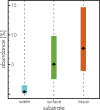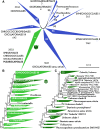Draft genome and description of Waterburya agarophytonicola gen. nov. sp. nov. (Pleurocapsales, Cyanobacteria): a seaweed symbiont
- PMID: 34674103
- PMCID: PMC8580901
- DOI: 10.1007/s10482-021-01672-x
Draft genome and description of Waterburya agarophytonicola gen. nov. sp. nov. (Pleurocapsales, Cyanobacteria): a seaweed symbiont
Abstract
This work introduces Waterburya agarophytonicola Bonthond and Shalygin gen. nov., sp. nov, a baeocyte producing cyanobacterium that was isolated from the rhodophyte Agarophyton vermiculophyllum (Ohmi) Gurgel et al., an invasive seaweed that has spread across the northern hemisphere. The new species genome reveals a diverse repertoire of chemotaxis and adhesion related genes, including genes coding for type IV pili assembly proteins and a high number of genes coding for filamentous hemagglutinin family (FHA) proteins. Among a genetic basis for the synthesis of siderophores, carotenoids and numerous vitamins, W. agarophytonicola is potentially capable of producing cobalamin (vitamin B12), for which A. vermiculophyllum is an auxotroph. With a taxonomic description of the genus and species and a draft genome, this study provides as a basis for future research, to uncover the nature of this geographically independent association between seaweed and cyanobiont.
Keywords: Cobalamin; Gracilaria vermiculophylla; Holobiont; Pleurocapsales; Symbiosis; Vitamin B12.
© 2021. The Author(s).
Conflict of interest statement
The authors declare that they have no conflict of interest.
Figures




Similar articles
-
Aliterella atlantica gen. nov., sp. nov., and Aliterella antarctica sp. nov., novel members of coccoid Cyanobacteria.Int J Syst Evol Microbiol. 2016 Sep;66(8):2853-2861. doi: 10.1099/ijsem.0.001066. Epub 2016 Apr 7. Int J Syst Evol Microbiol. 2016. PMID: 27054834
-
Odorella benthonica gen. & sp. nov. (Pleurocapsales, Cyanobacteria): an odor and prolific toxin producer isolated from a California aqueduct.J Phycol. 2019 Jun;55(3):509-520. doi: 10.1111/jpy.12834. Epub 2019 Feb 13. J Phycol. 2019. PMID: 30637743
-
Sungkyunkwania multivorans gen. nov., sp. nov., a member of the family Flavobacteriaceae isolated from seawater from a seaweed farm.Int J Syst Evol Microbiol. 2013 Jun;63(Pt 6):1995-2001. doi: 10.1099/ijs.0.043802-0. Epub 2012 Oct 5. Int J Syst Evol Microbiol. 2013. PMID: 23041634
-
Intraspecific diversity and genetic structure in the widespread macroalga Agarophyton vermiculophyllum.J Phycol. 2021 Oct;57(5):1403-1410. doi: 10.1111/jpy.13195. Epub 2021 Jul 22. J Phycol. 2021. PMID: 34218439 Review.
-
Shifting chemical defence or novel weapons? A review of defence traits in Agarophyton vermiculophyllum and other invasive seaweeds.Mar Life Sci Technol. 2021 Jul 5;4(1):138-149. doi: 10.1007/s42995-021-00109-8. eCollection 2022 Feb. Mar Life Sci Technol. 2021. PMID: 37073358 Free PMC article. Review.
Cited by
-
Epiphytic Bacterial Community Analysis of Ulva prolifera in Garorim and Muan Bays, Republic of Korea.Microorganisms. 2024 Jun 4;12(6):1142. doi: 10.3390/microorganisms12061142. Microorganisms. 2024. PMID: 38930524 Free PMC article.
-
Elevated Temperature-Induced Epimicrobiome Shifts in an Invasive Seaweed Gracilaria vermiculophylla.Microorganisms. 2023 Feb 27;11(3):599. doi: 10.3390/microorganisms11030599. Microorganisms. 2023. PMID: 36985173 Free PMC article.
-
Seasonal Cycles in a Seaweed Holobiont: A Multiyear Time Series Reveals Repetitive Microbial Shifts and Core Taxa.Environ Microbiol. 2025 Mar;27(3):e70062. doi: 10.1111/1462-2920.70062. Environ Microbiol. 2025. PMID: 40015318 Free PMC article.
-
Biodiversity of microorganisms in the Baltic Sea: the power of novel methods in the identification of marine microbes.FEMS Microbiol Rev. 2024 Sep 18;48(5):fuae024. doi: 10.1093/femsre/fuae024. FEMS Microbiol Rev. 2024. PMID: 39366767 Free PMC article. Review.
References
-
- Adams DG, Duggan PS. Signaling and communication in plant symbiosis. New York: Springer; 2012. Signalling in cyanobacteria–plant symbioses; pp. 93–121.
-
- Alneberg J, Bjarnason BS, De Bruijn I, et al. Binning metagenomic contigs by coverage and composition. Nat Methods. 2014;11:1144–1146. - PubMed
-
- Al-Thukair AA, Golubic S. New endolithic cyanobacteria from the arabian gulf. I. Hyella immanis sp. nov. 1. J Phycol. 1991;27:766–780.
-
- Altschul SF, Gish W, Miller W, et al. Basic local alignment search tool. J Mol Biol. 1990;215:403–410. - PubMed
MeSH terms
Substances
Grants and funding
LinkOut - more resources
Full Text Sources

